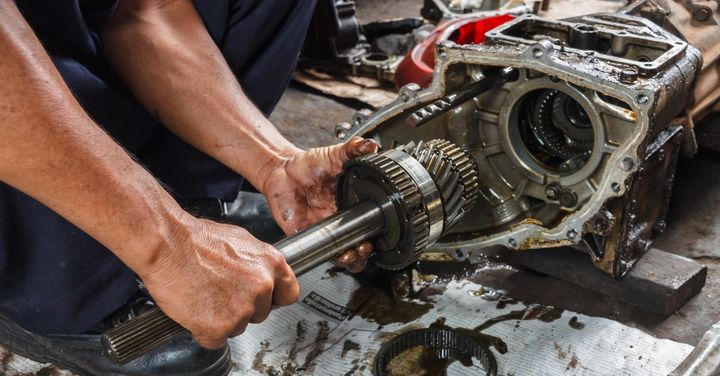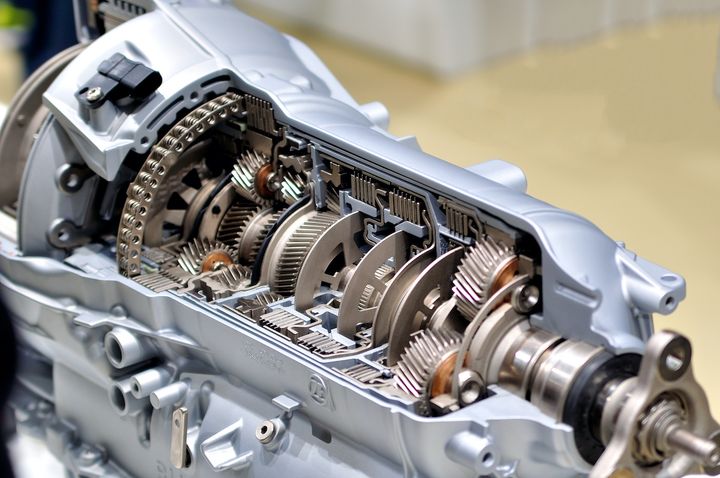


The transmission is a critical component in a vehicle's powertrain system, responsible for transferring the engine's power to the wheels. It acts as an intermediary between the engine and the wheels, allowing the vehicle to operate efficiently at different speeds and under varying load conditions.

There are several potential culprits that can prevent your transmission from engaging correctly. Let's explore the most common ones:
| Cause | Description |
|---|---|
| Low Transmission Fluid Level | Transmission fluid provides hydraulic pressure and lubrication for components to function. When levels are too low, the transmission can't build enough pressure to engage clutches and gears properly. |
| Worn/Damaged Clutch Components | Clutches engage and disengage gears during shifts. Worn clutch discs, damaged pressure plates, or faulty clutch packs can prevent smooth shifting or engagement. |
| Faulty Shift Solenoids/Sensors | Modern transmissions rely on solenoids and sensors to control gear shifts. Malfunctioning components can prevent the transmission from receiving correct shift signals. |
| Mechanical Issues | Internal problems like worn gears, bearings, bands, or other components can hinder proper engagement, often due to high mileage or lack of maintenance. |
Maintaining the correct fluid level is crucial for your transmission's operation. When levels drop too low, the transmission may not generate enough hydraulic pressure to engage the clutches and gears correctly. This issue can stem from leaks or simply a lack of regular maintenance and fluid changes.
Within your transmission, clutches are responsible for engaging and disengaging gears during shifts. Over time and with excessive wear, these components can become worn or damaged, preventing smooth gear changes or engagement altogether.
Common clutch component issues include:
Worn clutch discs
Damaged pressure plates
Faulty clutch packs
These problems often arise due to high mileage or excessive wear and tear on the transmission.
Modern transmissions heavily rely on electronic solenoids and sensors to control the gear shifting process precisely. If any of these components malfunction, the transmission may not receive the correct signals to engage the desired gear.
Potential causes of faulty shift solenoids or sensors include:
Electrical issues
Physical damage
General wear and tear over time
In some cases, the root cause of a non-engaging transmission can be attributed to internal mechanical problems within the transmission itself. These issues can include worn gears, bearings, bands, or other components.
Mechanical problems are often the result of:
High mileage
Lack of maintenance
Excessive strain on the transmission (e.g., towing heavy loads, frequent stop-and-go driving)
If you're experiencing issues with your transmission not engaging, the first step is to have a professional mechanic accurately diagnose the problem. Here are some of the diagnostic steps we typically follow:
| Diagnostic Step | Description |
|---|---|
| Check Fluid Level/Condition | Inspect transmission fluid level and quality for low levels or contamination, indicating leaks or other issues. |
| Listen for Unusual Noises | During engagement, listen for grinding, whining, or clunking sounds that can provide clues about the nature of the problem. |
| Check Diagnostic Trouble Codes | Connect a scan tool to retrieve any diagnostic trouble codes related to the transmission, which can help pinpoint the issue. |
| Perform Stall Test | Evaluate clutch operation and engagement capabilities by applying the brakes while attempting to engage the transmission in a specific gear. |
| Inspect for Leaks | Thoroughly inspect the transmission case and associated lines for any signs of fluid leaks contributing to low levels and engagement issues. |
Once the root cause has been identified, we can proceed with the appropriate repair procedures. Here are some common repair methods:

Locate and repair any leaks in the transmission system
Refill transmission fluid to the proper level using the correct fluid type and grade recommended by the manufacturer
Remove the transmission pan and inspect clutch discs, pressure plates, and other related components
Replace any worn or damaged clutch components with new ones
Use diagnostic tools to identify the specific faulty shift solenoids or sensors
Carefully remove and replace the defective components with new ones, ensuring proper installation and calibration
In cases of severe internal mechanical damage, a complete transmission overhaul or rebuild may be necessary:
Disassemble the entire transmission
Inspect and replace worn gears, bearings, bands, seals, and other internal components as needed
While transmission issues can sometimes be unavoidable, there are several preventive measures you can take to minimize the risk of engagement problems and extend the life of your transmission:
| Preventive Measure | Description |
|---|---|
| Follow Service Intervals | Adhere to the manufacturer's recommended transmission service intervals for regular fluid changes and inspections. |
| Use Correct Fluid Type/Grade | Always use the correct transmission fluid type and grade recommended by the manufacturer to prevent premature wear and leaks. |
| Avoid Excessive Strain | Be mindful of the transmission's limitations and avoid towing excessive weight or abusing the transmission through aggressive driving habits. |
| Address Issues Promptly | If you notice any signs of transmission problems (e.g., slipping gears, delayed engagement, unusual noises), have it inspected and addressed by a professional mechanic as soon as possible to prevent further damage. |
The cost of repairing a transmission that won't engage can vary significantly depending on the extent of the damage and the specific repair procedures required. Here's a general overview of potential costs:
Minor Repairs (Fluid Changes, Solenoid Replacements): For minor issues like low fluid levels or faulty solenoids, the repair costs can range from a few hundred dollars to around $1,000, depending on the make and model of your vehicle.
Clutch Component Replacements: Replacing worn or damaged clutch components can cost anywhere from $1,000 to $2,500, depending on the complexity of the job and the parts required.
Complete Transmission Overhaul or Rebuild: In cases where a complete transmission overhaul or rebuild is necessary, you can expect to pay between $2,000 and $5,000 or more, depending on the make and model of your vehicle, as well as the labor costs at the repair shop.
Transmission Replacement: In some severe cases, a complete transmission replacement may be the only viable option. This can be the most expensive repair, with costs ranging from $3,000 to $8,000 or more, including the cost of the new transmission and labor.
It's important to note that these cost estimates are rough guidelines, and the actual cost may vary based on your specific situation and the repair shop you choose. It's always advisable to obtain multiple quotes from reputable mechanics or dealerships to ensure you're getting a fair price for the necessary repairs.
A transmission that won't engage can be a frustrating and potentially costly issue to deal with. However, by understanding the main causes, diagnostic steps, repair procedures, and preventive measures, you can be better prepared to address this problem should it arise.
As an experienced automotive mechanic, I cannot stress enough the importance of regular maintenance and addressing any transmission issues promptly. By taking proper care of your vehicle's transmission and seeking professional assistance when needed, you can help prevent more severe and expensive problems down the road.
Remember, a well-maintained transmission is essential for the smooth and reliable operation of your vehicle. Don't hesitate to consult with a qualified mechanic if you suspect any issues with your transmission's engagement or performance. Early detection and proper repairs can save you significant time, money, and hassle in the long run.
Common symptoms include slipping gears, delayed or rough shifting, grinding or whining noises, leaking fluid, and the transmission refusing to go into gear. Pay attention to any unusual behavior or performance changes.
While basic checks like inspecting fluid levels and checking for leaks can be done by the owner, most transmission issues require professional diagnosis using specialized tools and equipment.
Aggressive driving, such as sudden acceleration, hard braking, and frequent stop-and-go traffic, can accelerate transmission wear and tear. Gentle driving habits and avoiding excessive strain can help prolong transmission life.
Yes, manual transmissions typically require less frequent maintenance, but clutch components may need replacement more often. Automatic transmissions have more complex fluid and filter maintenance requirements.
The TCM is the computer that controls and monitors the transmission's operation. A faulty TCM can cause shifting issues, erratic behavior, and other transmission problems.
While it is possible to change transmission fluid yourself, it is generally recommended to have it done by a professional, as improper fluid changes can introduce contaminants and cause further issues.
Transmission service intervals vary based on the manufacturer's recommendations, driving conditions, and the type of transmission. Typically, it is recommended every 30,000 to 100,000 miles.
Look for reddish-brown fluid spots or puddles under your parked vehicle. You may also notice a sweet, burning smell or low fluid levels on the dipstick.
It is generally not recommended to continue driving with a known transmission issue, as it can lead to further damage and potentially leave you stranded. Seek professional assistance as soon as possible.
The time required for a transmission rebuild or replacement can vary depending on the complexity of the job and the availability of parts, but it typically ranges from a few days to a week or more.

Sarah isn't your average gearhead. With a double major in Mechanical Engineering and Automotive Technology, she dived straight into the world of car repair. After 15 years of turning wrenches at dealerships and independent shops, Sarah joined MICDOT to share her expertise and passion for making cars run like new. Her in-depth knowledge and knack for explaining complex issues in simple terms make her a valuable asset to our team.



